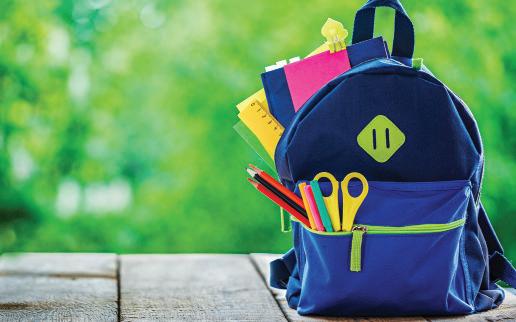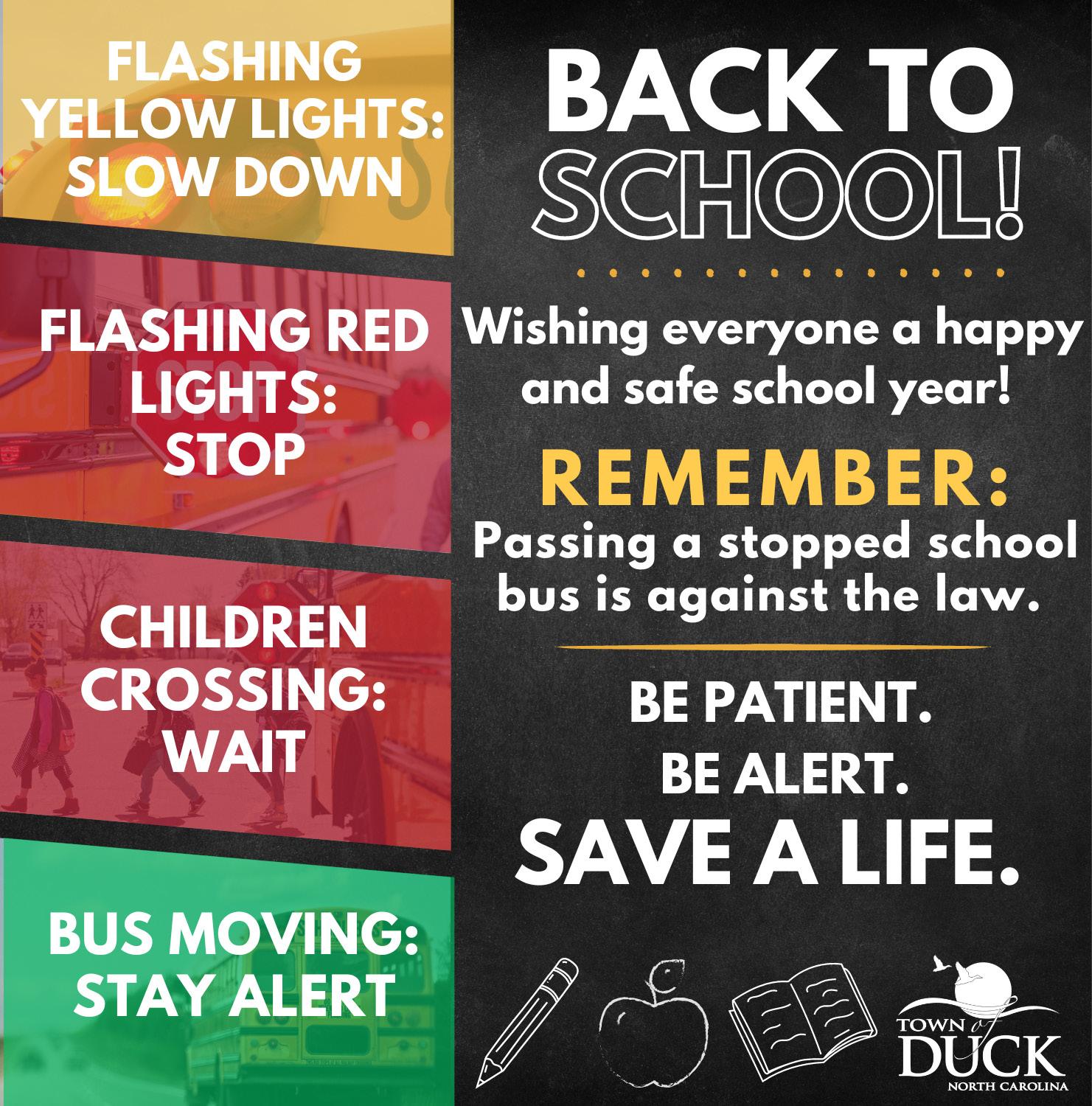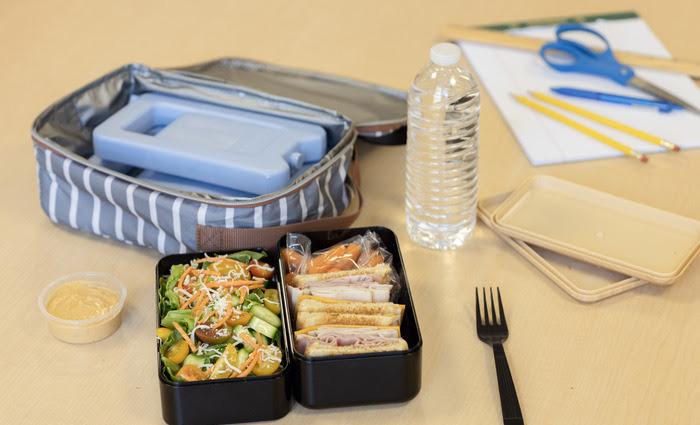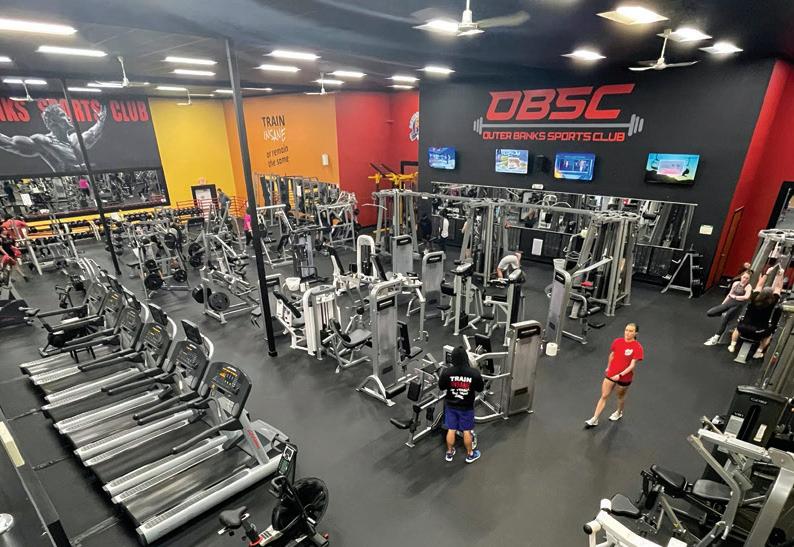BACK TO SCHOOL



Whether it’s because the family has moved, the school district shifted or just because your student is switching from elementary to middle or middle to high school, starting a new school can be stressful.
Here are some tips to keep everyone on an even keel during the transition.
Acknowledge their feelings: Make sure your child feels seen and heard. Validate their feelings of fear, but also encourage them to embrace the adventure ahead of them.
Ask questions: Let your students

talk about their concerns and work with them to find solutions to their problems.
Talk to the school: Share your concerns with your child’s teachers and let them share their expertise with you. They can help your child focus on what they like to do instead of the scary feelings of being in a new school.
Practice makes perfect: Practice your new routine. Walk to the school or the bus stop. Have them meet their teachers ahead of time. Attend orientations or other events meant to acquaint you with their


new school.
Establish routines in advance: Start your school routines well before the first day to give your student time to adjust to the new routine. If they’re starting kindergarten, make sure they can do things on their own like wash their hands and open their lunch items.
Start a calendar: Help your student plan their time by giving them a planner or calendar and helping them set it up. For littles, consider a visual calendar that will help them see what their day will be like.
Lead by example: Children pick
up on your energy. If you’re anxious, try to work that out with friends or family or your partner, not the kid. Focus on the positive about the new school with them and ask them open-ended questions that allow them to fully express their feelings and opinions.
Talk to someone: Make sure your student has someone they can talk to, especially someone that can relate to what they’re going through. This can be a sibling, an older family friend or family member, or anyone else they (and you) trust to help them through it.

egistrations at community colleges that focus on vocational programs saw registrations climb 16% in fall 2023, Newsweek reported, a substantial spike in enrollment.
Jennifer Causey, a senior research associate at the National Student Clearinghouse Research Center, says recent years have seen a considerable uptick in the interest in vocational and technical programs.
“Since fall 2021, vocational programs have started to see upticks in enrollments, and specific program families such as mechanic repair technologies grew 11.2% this fall alone,” she says.
Lisa Countryman-
Quiroz sees that growth in skilled trades as part of a generational comeback. The CEO of Jewish Vocational Service told NPR that skilled trades are a particular favorite career choice of Gen Z.
“Folks have really prioritized a college education as a path to the middle class and a path to a cushy office job,” she says. “Over the last 1015 years, we are seeing a trend among young people opting out of universities. Just the crushing debt of college is becoming a barrier in and of itself.”
A survey by the think tank New America shows more than half of Gen Z say it’s possible to get a well-paying job with only

a high school diploma, if you learn other skills. And that it makes perfect sense, given the high cost


of college. “It’s not a secret that the cost of college has gone up so dramatically in the last decade that it’s really cost prohibitive at this point,”
Nitzan Pelman, founder of Climb Hire, told NPR. Climb Hire helps low-income and overlooked people find new careers.
Also, there’s $1.2
trillion in federal spending trickling down to the skilled trades. President Joe Biden signed the bipartisan infrastructure bill in 2021, with the goal, at least partially, to create jobs in the skilled trades. It includes money for things like roads and bridges, public transit, airports, electric vehicles, power infrastructure and more.
“America is moving again, and your life is going to change for the better,” Biden said when he signed the bill. “This law is a blue-collar blueprint to rebuild America. It leaves no one behind and marks an inflection point that we face as a nation.”

It’s that time of year again: back-to-school.
Alongside purchasing new backpacks and notebooks, it’s essential to also stock up on lunchbox essentials that will keep your child’s homemade lunches safe: insulated soft-sided lunch bags, two cold sources and insulated containers for hot foods, noted the USDA.
How to pack a safe lunch
For cold lunches, use a soft-sided lunch bag and include at least two cold sources. You can use two frozen gel packs (not smaller than 5x3 inches each) or combine a frozen gel pack with a frozen juice box or frozen bottle of water. Place cold sources on top and bottom of the perishable


food items to keep them cold. If there’s a refrigerator available at the school, store perishable items there upon arrival. Remember to leave the lid or lunch bag open so that cold air can circulate and keep the food cold.
For hot lunches, use a clean and insulated container to keep food like soup, chili and stew hot. Fill the container with boiling water, let it stand for a few minutes, empty and then put in the piping hot food. Keep the insulated container closed until lunchtime to keep the food hot — 140 F or above.
After lunch, discard all leftover food, used disposable food packaging and paper bags. Do not reuse disposable packaging because it could contaminate other food and cause foodborne
illness. To learn more about how to properly pack a school lunch, go to fsis.usda.gov/ food-safety/safe-foodhandling-and-preparation/food-safety-basics/ keeping-bag-lunches-safe. Other safer options that do not require refrigeration include whole fruits and vegetables, hard cheese, canned meat and fish, chips, breads, crackers, jerky, jelly, mustard and pickles. For more information about food safety, call the USDA Meat and Poultry Hotline at 1-888-MPHotline (1-888-674-6854), email MPHotline@usda. gov, or chat live at ask.usda.gov from 10 a.m. to 6 p.m. Eastern Time, Monday through Friday to reach a food safety specialist in English or Spanish.












The American Academy of Pediatrics recommends no screen time for children under age 2, one hour per day for children 2-12, and two hours per day for teens and adults. Keep in mind that screen time includes more than just the TV. It also includes being on a smart phone, reading on a tablet, using an ATM and working on a laptop.
Health benefits
The Mayo Clinic says there are numerous benefits to reducing screen time, including improved physical health, decreased obesity and more time for kids to play and explore the world around
them. Too much screen time puts kids and adults alike at risk for obesity, sleep disturbances and it can adversely affect personal relationships. It can spike anxiety and depression and seems to be related to a decreased attention span, the Mayo Clinic says.
Reducing screen time
The Mayo Clinic offers these tips for slimming down screen time:
• Be accountable. Set expectations and goals, then be intentional about reducing screen time.
• Be realistic. Set smaller, more attainable goals at first. Take baby steps by cutting screen time in half each week until you’ve
reached the recommended amount.
• Be engaged. Put down the phone. Spend time each day talking faceto-face with kids, giving them your full attention. Have the whole family participate in screen-free hours, where everyone puts their devices away in a common area.
• Establish phone-free zones. Establish zones in the home where phones aren’t allowed, such as at the dinner table.
• Get outside. Take a walk, play outdoors, garden, do chores together. Getting outside can boost endorphins, improving your mood and your physical health.



Managing their digital life
Teach your kids that, when they are on a screen (increasingly, that means being online in some way), they need to be kind, both




to others and to themselves. Make sure your kids are aware of online safety, such as not giving out personal information, not falling for scams or phishing schemes and not
giving out passwords. Consider working with your children to choose and use a monitoring software to help teach them how to be online, safely.

Cell phones, once a luxury, are now a necessity for students.
As many head off to college, they may no longer qualify — or want to qualify — for their parents’ plan. But, they want to stay in touch with family and friends and have the latest tech for both studying and socializing.
Unlimited data
Most phone companies offer an unlimited data option, but it’s not cheap. However, it may be the best thing for a student to have because they use their phones for everything, and not always on Wi-Fi. For an idea of how much data your student uses, monitor the past few months of their usage on the family plan, then average it out.
Most campuses have campus-wide Wi-Fi, though coverage in buildings can sometimes be
spotty. If your student is good about making sure they’re making calls and using data on the Wi-Fi, you may be able to get away with a less expensive plan.
Ask whether your carrier throttles data; remember, unlimited plans may mean the data will still flow, but just more slowly after a certain point.
Monthly charges
There’s more than just the price of the plan. Consider the cost of the phone, which is often spread out over several months, and any fees and extra features they want to add. Ask each company for student discounts, and be prepared to provide a copy of a transcript or a student ID if asked.
Review your bills to make sure all the fees you’re being charged are legitimate and you haven’t accidentally signed up for a paid service you
didn’t intend to. Keep an eye out for any overage fees you may incur and adjust your plan and usage accordingly.
International calling If your student plans to travel internationally or participate in a longterm study abroad program, talk to your carrier about whether their plan handles international calling or whether it can be temporarily converted while they’re traveling abroad.
Insurance
Make sure your phone is covered by insurance or a repair plan, and know the terms and conditions before it’s an emergency situation. Explore any protections your credit card or bank offers. Check the terms for if the phone is lost or stolen as well, and know the procedure for getting a replacement quickly.

ids’ lives tend to only get busier as they get older, and an important skill to help them both now and as they grow up is good time management.
Try these strategies to keep your teen on track this school year.
Learn to prioritize
Start by giving teens a problem they can relate to. For instance, they know if they have money, from a birthday or a summer job, they can afford to buy one thing and not another. Teach them that time works the same way. They can spend that time on whatever they want, just like their money, but they’ll need to prioritize tasks to get the outcome they want.
Going away from home is a big step for your college freshman. But remember, they aren’t just leaving home, they’re also leaving doctors and other health care professionals that they’ve relied upon. Here’s how you can help your student get health care established in their new city.
Insurance options
Your college or university’s student health plan may be an affordable way to have your student’s health care needs met. If your student is staying in the same state as you, you can keep them on your plan as long as they are a dependent under the age of 26. If they’re in a different state, they can apply for coverage with

Instead of imposing a tracking system that might work for you, help your teen navigate the
focusing on systems, not reminders. Ask your teen to create ways of reminding themselves to do things instead of doing the reminding (read: nagging) for them. And let them fail once in a while. That’s how they learn.
Teach by giving chores Reinforce time management by assigning your teen time-oriented tasks, such as remembering to let the dog out at a certain time. Make sure to recognize them for completing the task on their own.
Break it down
Break bigger goals down into more manageable chunks. Instead of a college application deadline, set smaller deadlines of getting letters of recommendation, writing the
you, but be aware of the plan’s limitations in their area. They can apply for their own plan in the state where they go to school. For students that are older than 26 and not claimed as a dependent, they can fill out their own application on the health care marketplace, even if they still live with their parents.
Finding a doctor For simple health needs, most campuses have a health clinic that serves the student population. Usually, these clinics diagnose and treat minor illnesses and injuries, test for and treat sexually transmitted diseases and handle preventive care. They may be able to give immunizations
and handle some mental health issues.
Charges for these services may be waived or minimal. Talk to the student services department to learn more about your campus’ services. If the campus doesn’t have a clinic or the student is not comfortable getting care there, talk to your family doctor or other health care professional at home about finding a doctor in your new town. Your family doctor may know of a colleague in the area accepting patients or be part of a network with connections there.
essay and mailing it off. Ask them to come up with a flexible schedule for getting each task done and discuss with them any challenges they foresee along the way.
Leave room for failure
Remember that kids, like us, aren’t perfect. They’re going to make mistakes, miss deadlines and mess up tasks. Invite them to learn from those experiences and help them come up with ways to improve next time.
Limit time online
We’ve all experienced the great time sink that is the latest and greatest app. Start establishing healthy online habits as early as you can to help the whole family better manage their digital lives.

Once your student finds a doctor, they should get care established as soon as they are able and not wait until they’re sick. This will allow the doctor to take a full medical history and address any




concerns without the added stress of an urgent or even emergent situation. They can help manage prescriptions and



































































































































